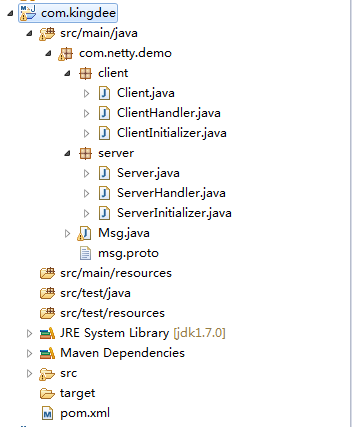ProtoBuf和Netty的简单使用

1.pom.xml:
当然,也可建立个java工程把jar包放进去
1 <project xmlns="http://maven.apache.org/POM/4.0.0" xmlns:xsi="http://www.w3.org/2001/XMLSchema-instance"2 xsi:schemaLocation="http://maven.apache.org/POM/4.0.0 http://maven.apache.org/xsd/maven-4.0.0.xsd">3 <modelVersion>4.0.0</modelVersion>4 <groupId>netty-demo</groupId>5 <artifactId>com.kingdee</artifactId>6 <version>0.0.1-SNAPSHOT</version>7 <properties>8 <project.build.sourceEncoding>UTF-8</project.build.sourceEncoding>9 <spring.version>3.2.5.RELEASE</spring.version>10 <spring.rabbit.version>1.3.5.RELEASE</spring.rabbit.version>11 </properties>12 <dependencies>13 <dependency>14 <groupId>org.springframework</groupId>15 <artifactId>spring-context</artifactId>16 <version>${spring.version}</version>17 </dependency>1819 <!-- https://mvnrepository.com/artifact/io.netty/netty-all -->20 <dependency>21 <groupId>io.netty</groupId>22 <artifactId>netty-all</artifactId>23 <version>4.0.23.Final</version>24 </dependency>2526 <!-- https://mvnrepository.com/artifact/log4j/log4j -->27 <dependency>28 <groupId>log4j</groupId>29 <artifactId>log4j</artifactId>30 <version>1.2.17</version>31 </dependency>3233 <!-- https://mvnrepository.com/artifact/commons-logging/commons-logging -->34 <dependency>35 <groupId>commons-logging</groupId>36 <artifactId>commons-logging</artifactId>37 <version>1.1.1</version>38 </dependency>3940 <dependency>41 <groupId>com.google.protobuf</groupId>42 <artifactId>protobuf-java</artifactId>43 <version>3.0.0</version>44 </dependency>45 </dependencies>46 </project>
2.msg.proto,把它转换成java代码,再拷贝到对应的包下,利用proto.exe工具生成
mgs.proto:
它是传输的实体类,有两个部分,client和service
传输数据时可以直接.来选择调用哪个对象
package com.netty.demo;message Client {required string head = 1;required string body = 2;}message Server {required int32 code=1;required string message=2;}
在protoc.exe下面放proto文件,通过命令生成这个传输实体类

3.客户端代码:
Client.java:
package com.netty.demo.client;import io.netty.bootstrap.Bootstrap;import io.netty.channel.ChannelFuture;import io.netty.channel.EventLoopGroup;import io.netty.channel.nio.NioEventLoopGroup;import io.netty.channel.socket.nio.NioSocketChannel;public class Client {public static String host = "127.0.0.1";public static int port = 8787;public static void main(String[] args) {EventLoopGroup worker = new NioEventLoopGroup();Bootstrap b = new Bootstrap();b.group(worker);b.channel(NioSocketChannel.class);b.handler(new ClientInitializer());try {ChannelFuture f = b.connect(host, port).sync();f.channel().closeFuture().sync();} catch (InterruptedException e) {e.printStackTrace();} finally {worker.shutdownGracefully();}}}

ClientHandler.java(处理客户端消息发送和收到服务端消息的处理,但一般情况下是不会在这里写发送消息的逻辑的,只是为了写demo,所以把发消息写在这里面)
package com.netty.demo.client;import io.netty.channel.ChannelHandlerContext;import io.netty.channel.SimpleChannelInboundHandler;import com.google.protobuf.Message;import com.netty.demo.Msg;public class ClientHandler extends SimpleChannelInboundHandler<Message> {/****/protected void channelRead0(ChannelHandlerContext ctx, Message msg) throws Exception {System.out.println("Server say : " + msg.toString());}/****/public void channelActive(ChannelHandlerContext ctx) throws Exception {System.out.println("Client active ");Msg.Client msg = Msg.Client.newBuilder().setHead("Content-Type:application/json;charset=UTF-8").setBody("hello world!").build();ctx.writeAndFlush(msg);super.channelActive(ctx);}@Overridepublic void channelInactive(ChannelHandlerContext ctx) throws Exception {System.out.println("Client close ");super.channelInactive(ctx);}}
ClientInitializer.java(初始化Chanel,如解码,加密等),最早的netty传protobuf,是需要手动toByteArrary()把传输对象序列化成二进制流发出去,接收端再手动反序列化还原成传输对象。
但是后来通过设置protubuf编码解码器,就可以自动实现序列化和反序列化,传输时只需要把实体发出去就行了。
package com.netty.demo.client;import com.netty.demo.Msg;import io.netty.channel.ChannelInitializer;import io.netty.channel.socket.SocketChannel;import io.netty.handler.codec.LengthFieldBasedFrameDecoder;import io.netty.handler.codec.LengthFieldPrepender;import io.netty.handler.codec.protobuf.ProtobufDecoder;import io.netty.handler.codec.protobuf.ProtobufEncoder;public class ClientInitializer extends ChannelInitializer<SocketChannel> {protected void initChannel(SocketChannel ch) throws Exception {// decodedch.pipeline().addLast(new LengthFieldBasedFrameDecoder(1024, 0, 4, 0, 4));//这里是收到服务端发过来的消息,所以是对服务端的response解码ch.pipeline().addLast(new ProtobufDecoder(Msg.Server.getDefaultInstance()));// encodedch.pipeline().addLast(new LengthFieldPrepender(4));ch.pipeline().addLast(new ProtobufEncoder());// 注册handlerch.pipeline().addLast(new ClientHandler());}}

4.Server端代码:
Server.java
package com.netty.demo.server;import io.netty.bootstrap.ServerBootstrap;import io.netty.channel.ChannelFuture;import io.netty.channel.ChannelOption;import io.netty.channel.EventLoopGroup;import io.netty.channel.nio.NioEventLoopGroup;import io.netty.channel.socket.nio.NioServerSocketChannel;public class Server {private static int port = 8787;public static void main(String[] args) {EventLoopGroup boss = new NioEventLoopGroup();EventLoopGroup worker = new NioEventLoopGroup();ServerBootstrap server = new ServerBootstrap();server.group(boss, worker);server.channel(NioServerSocketChannel.class);server.childHandler(new ServerInitializer());server.option(ChannelOption.SO_BACKLOG, 128);server.childOption(ChannelOption.SO_KEEPALIVE, true);try {//绑定端口 同步等待成功ChannelFuture f = server.bind(port).sync();//等待服务端监听端口关闭f.channel().closeFuture().sync();} catch (InterruptedException e) {e.printStackTrace();} finally {worker.shutdownGracefully();boss.shutdownGracefully();}}}

ServerHandler.java:
package com.netty.demo.server;import java.net.InetAddress;import com.google.protobuf.Message;import com.netty.demo.Msg;import com.netty.demo.Msg.Client;import io.netty.channel.ChannelHandlerContext;import io.netty.channel.SimpleChannelInboundHandler;/*** 处理客户端连接时的handler** @author shizhengchao32677**/public class ServerHandler extends SimpleChannelInboundHandler<Message> {/*** 收到客户端发过来的消息*/protected void channelRead0(ChannelHandlerContext ctx, Message msg) throws Exception {// 收到消息直接打印输出System.out.println(msg.getClass());Msg.Server response = null;if(msg instanceof Msg.Client) {Msg.Client clientMsg = (Client) msg;System.out.println(ctx.channel().remoteAddress() + " Say : " + clientMsg.getBody());response = Msg.Server.newBuilder().setCode(0).setMessage("Received client message success").build();} else {response = Msg.Server.newBuilder().setCode(-1).setMessage("client message is illegal").build();System.out.println("client message is illegal");}// 返回客户端消息 - 我已经接收到了你的消息ctx.writeAndFlush(response);}/** 覆盖 channelActive 方法 在channel被启用的时候触发 (在建立连接的时候)*/public void channelActive(ChannelHandlerContext ctx) throws Exception {System.out.println("RamoteAddress : " + ctx.channel().remoteAddress() + " active !");String welcome = "Welcome to " + InetAddress.getLocalHost().getHostName() + " service!";Msg.Server response = Msg.Server.newBuilder().setCode(101).setMessage(welcome).build();ctx.writeAndFlush(response);super.channelActive(ctx);}}
ServerInitializer.java
package com.netty.demo.server;import io.netty.channel.ChannelInitializer;import io.netty.channel.socket.SocketChannel;import io.netty.handler.codec.LengthFieldBasedFrameDecoder;import io.netty.handler.codec.LengthFieldPrepender;import io.netty.handler.codec.protobuf.ProtobufDecoder;import io.netty.handler.codec.protobuf.ProtobufEncoder;import com.netty.demo.Msg;public class ServerInitializer extends ChannelInitializer<SocketChannel> {protected void initChannel(SocketChannel ch) throws Exception {// decodedch.pipeline().addLast(new LengthFieldBasedFrameDecoder(1024, 0, 4, 0, 4));//解码客户端发过来的消息ch.pipeline().addLast(new ProtobufDecoder(Msg.Client.getDefaultInstance()));// encodedch.pipeline().addLast(new LengthFieldPrepender(4));ch.pipeline().addLast(new ProtobufEncoder());// 注册handlerch.pipeline().addLast(new ServerHandler());}}
运行Server.java和Client.java:
Server输出:RamoteAddress : /127.0.0.1:59693 active !class com.netty.demo.Msg$Client/127.0.0.1:59693 Say : hello world!Clientl输出:Client activeServer say : code: 101message: "Welcome to H4UOJJQSF23HQ91 service!"Server say : code: 0message: "Received client message success"






























![自动化测试框架[Cypress测试用例] 自动化测试框架[Cypress测试用例]](https://image.dandelioncloud.cn/images/20221120/661ddfd86c1048fdad266297858134f9.png)




还没有评论,来说两句吧...